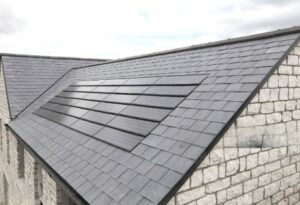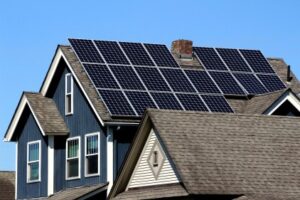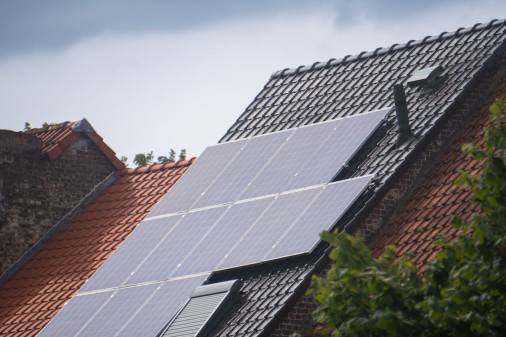Solar Shingles vs Solar Panels Compared (Pros & Cons)
S
olar shingles are an alternative roofing material designed to harness solar energy. The shingles generally gel into the roof well whereas panels often stand out, sometimes making it making it look a bit awkward. Solar shingles are thinner and lighter than the panels but have low energy conversion efficiency compared with panels. Apart from this, it is next to impossible to reposition solar shingles in case you want to move home. However solar panels can be easily shifted and mounted to various types of roofs if needed. These are some basic differences between the utility of both solar devices. Both have their fair share of pros and cons.
This blog presents you a comprehensive comparison between these two solar systems based on a number of parameters. Read further to get a picture of how solar shingles differ from solar panels, what are their pros & cons, and which one you should pick for your renewable energy needs. Towards the end, we have also provided a list of different brands. Solar Findings does not have any affiliation with the brands in any shape or form, and have placed them solely for the benefit of our readers.
Table of Contents
- Solar Shingles - Pros & Cons
- Solar Panels - Pros & Cons
- Solar Shingles vs Solar Panels Compared
- Suitability Comparison
- Cost Comparison
- Efficiency Comparison
- Curb Appeal Compared
- Flexibility Comparison
- Durability Comparison
- Dimension Comparison
- Warranty Comparison
- Sustainability Comparison
- Where Can I Buy Solar Shingles?
- Final Thoughts
- FAQs
Solar Shingles – Pros & Cons
Solar shingles are roofing materials containing slim photovoltaic sheets. The photovoltaic sheets convert the sunlight incident on them to electricity. A solar shingle is typically made from semiconductors like Copper Indium Gallium Selenide which is responsible for making it a flexible and thin material. The efficiency of conversion is 14%-18% which is less than the conventional solar panels (~22%).

Solar shingles belong to the category of solar energy products called Building-Integrated Photovoltaics (BIPV). A solar shingle performs two functions- it generates energy like a conventional solar panel as well as provides a roofing system for the house. They require an inverter like solar panels and can be used for both on-grid and off-grid systems. The dual functioning of these systems adds to their cost of installation. To install a Photovoltaic shingle, the contractor either needs to replace the existing roof or install it on new construction.
There are certain pros and cons of Solar roof tile installation. Here, we discuss some of them in brief.
Solar Shingles – Pros
The sleek and modernized roofing tile increases the aesthetic value of your home.
The shingles do not pop out of the roof and the panels remain camouflaged well. Tesla is working to manufacture different colored shingles to match the roof types.
Installation of a solar shingle increases the value of your property.
Solar shingles feature the advancement in technology.
Solar Shingles – Cons
Solar shingles are not an economically favorable option.
The energy conversion efficiency is low when compared to traditional solar panels.
There are more shingles for every panel in the same square foot area. Thus, more electrical connections are required, and it may increase the rate of failure.
Solar Shingles are relatively new in the solar market; therefore, it is difficult to find installers.
Solar shingles cannot be adjusted to receive the maximum amount of sunlight. This in turn affects the amount of energy generated.
If you want to move house, you need to leave the shingles intact for the next buyer to avoid damaging the roof.
Solar Panels – Pros & Cons
A solar panel is made up of solar cells that convert sunlight into electricity. These panels generate a Direct current and like solar shingles must be connected to an inverter. The inverter is required to convert a Direct current into an Alternating current. Depending on the process of solar cell production, a solar panel may be monocrystalline, polycrystalline, or thin-film panel. The monocrystalline solar panel outperforms the rest of the others. However, the installation of a polycrystalline panel can be considered depending on the energy requirements of the house. Recently, there have been more types of solar panels available in the booming market of solar energy.

The pros and cons of solar panels are discussed here.
Solar Panels – Pros
- Solar panels are more affordable than solar shingles.
- many local companies are offering solar panel installation and maintenance services.
- Solar panels are more efficient at energy conversion (~22%) and have high power output.
- There is less chance of solar panel failure.
- The process of installation is easy and less time-consuming. A DIY solar panel kit can also help you to go green without much of a mess.
Solar Panels – Cons
- The panels are heavy and may add more weight to the roofs.
- Installation of solar panels on the roof gives a pop-up appearance. This may not be aesthetically pleasing to some homeowners.
- Roofs must the strong and intact before installation of panels.
- Solar panels occupy more space on the roof because of their large size.
Solar Shingles vs Solar Panels – A Comprehensive Comparison
Despite the similarity in the functioning of a solar panel and a solar shingle, there are some key differences between them. These differences are listed below.
Solar Panels Vs Solar Shingles | Suitability
Solar shingles are not only advanced technology but also have a more sophisticated look than traditional panels. The aesthetically appealing solar shingles can help you save time and money as they can be installed at the same time as your original roof. The old-age solar panels occupy more space, hence additional construction is required. A solar shingle can be opted for when a new home is constructed, or the entire roof needs a replacement. In case there is no requirement to repair the roof you have, and the roof is strong enough to withstand the additional weight of solar panels, solar panels could be the right choice. As solar panels only generate energy whereas solar shingles form a part of the roof or the entire roof along with energy generation, a choice must be made depending on the purpose of installationts.
Solar Panels Vs Solar Shingles | Cost
Solar roof tiles can end up costing you double, compared to solar panels. For solar shingles, the estimated range should be around $40k- $60k before adding in any tax credit from the manufacturer, what type of roof, and method of installation. The average should be around $15-$25 per square foot. Whereas the installation cost of a solar panel is less ranging between $15-$26K and the average cost of solar panels ranges between $4-$10/per square foot, they are much cheaper than solar roof tiles.
Solar Panels Vs Solar Shingles | Cost of Maintenance
Solar shingles, once installed, barely require additional maintenance. Solar panels tend to have their surfaces cleaned at least twice a year in order to remove the accumulation of dust or debris that may tamper with their energy output. This is where solar shingles and solar panels become cost-effective in the long run.
Solar Panels Vs Solar Shingles | Efficiency
In comparison to solar shingles, solar panels have proved to be more energy efficient. When solar panels are installed on the roof, there is some gap between the panel and the roof which allows the heat to dissipate. Whereas there is no space for the dissipation of heat in the case of a solar shingle as the shingle is the roof replacement. While it is possible to reposition solar panels, solar roof titles are quite rigidly positioned and cannot be moved easily.
In terms of wattage, the panels show a range between 170W to 450W, whereas a shingle offers between 13W to 170W. This means, that to get the same amount of wattage, you need to install many more highly energy-efficient solar shingles than the number of panels.
Solar Panels Vs Solar Shingles | Curb Appeal
Installation of solar panels on roofs may not look aesthetically pleasing. The bulky-looking panels may take up a lot of space on the roof. After adding solar panels, the overall curb appeal of the home or office may seem to be awkward.
Solar shingles blend in with the look of the house and the Solar roof tiles give your roof an aesthetic look and are the main reason for homeowners to purchase them
Solar Shingles Vs Solar Panels | Flexibility
Solar shingles are tailored to fit the tilted or sloped roofs to replace the asphalt tiles. However, a solar panel can be installed on any roof type. Once the solar shingles are installed, they cannot be repositioned. On the contrary, when moving to a new residence, solar panels can be easily shifted to the new location. Solar panels offer more flexibility in terms of mounting and repositioning.
Solar Shingles Vs Solar Panels | Durability
Both solar panels and solar shingles can function optimally for 25-30 years. Advancements in technology have improved their resistance to harsh weather conditions without affecting their output for two decades. After two decades, the efficiency gets slightly decreased.
Solar Shingles Vs Solar Panels | Dimensions
The size of solar shingles is like standard shingles, that is 12*86 inches, and the thickness is less than an inch. The weight of the solar shingle is 13 pounds a square foot. Being lighter in weight than solar panels, solar shingles do not need any kind of bracket or mount installation.
Solar panel sizes are typically 39*65 inches, and the weigh 40 pounds, therefore the excellent condition of the roof is a pre-requisite for panel installation.
Solar Shingles Vs Solar Panels | Warranty
Companies selling solar panels often give a warranty to protect the investment. The
product warranty lasts for 25 years and provides coverage for manufacturing
defects in the materials or the workmanship. In case of any defect, the
manufacturer generally repair or replace the panels.
The warranty for solar shingles generally last for 20 years and covers any defects in the material as well as workmanship. The manufacturer solves any manufacturing defects during this period.
It is very important to be thorough with the terms and conditions of the warranty before purchasing a panel or a shingle–to be well aware of the coverage and limitations. It is advisable to buy a solar system from a well-esteemed manufacturer known for honoring warranty claims and protecting the investment in solar systems.
Solar Shingles Vs Solar Panels | Eco Friendly Factor
Solar panels as well as solar shingles produce green energy and reduce carbon footprint. However, the manufacturing of solar panels needs rare earth elements that require more energy and resources. Along with this, for installing solar panels, the traditional roof needs to be replaced. New materials for installing the panel are required, and this in turn introduces some negative consequences on the carbon footprint.
On the other hand, solar shingles do not need any additional material for installation. Also, the rare earth elements used for manufacturing shingles are recyclable. Hence resulting in a higher environmental impact than a panel and significantly less negative impact than other forms of roofing
Where Can I Buy Solar Shingles ?
Solar Shingles were introduced back in 2011 by DOW company. After gaining popularity in the solar market, Tesla launched their product in 2016, and to date, it is a popular choice due to its high efficiency.
Unlike a solar shingles, solar panels are easily available from the local solar company. Shingles are less popular and only a few companies render its services like installation.
Here’s a list of some companies other than Tesla Solar that manufacture shingles along with some product suggestions-
1. CertainTeed
Available all across the USA, their Solstice Shingle roofing solution offered by them provides beauty, efficiency, and durability all in one solution! Here’s the link if you want to know more.- https://www.certainteed.com/products/solar-products/solstice-shingle
2. GAF Materials Corporation
Promising hassle-free, advanced solar roof solutions with a promising warranty, GAF’s Timberline Solar shingles are water-shedding and strong and designed to withstand winds up to 130 mph. Check out their website to know more- https://www.gaf.energy/timberline-solar/
3. Luma Solar Roof
Luma Roof offers integrated solar roof solutions that are custom-made and a lifetime warranty for the metal shingles. Visit their website to know more! https://lumasolar.com/
4. SunTegra Shingles
Their shingles attach to the roof directly, integrating with composition shingles and other low-profile roofing materials. Check out their high-performing products here- https://www.suntegrasolar.com/suntegra-shingles/
Solar Panels & shingles – Final Thoughts
Solar panels and solar shingles may seem similar in function. However, the solar panels are designed for energy generation only and solar shingles are designed to be used as an alternative roofing. Homeowners can consider installing solar shingles when a new home is purchased or the entire roof needs replacement. Solar panels can be installed when you already have your ideal roof. Unlike solar panels, there are no additional conventional components for installing a solar shingles. Hence, less carbon footprint is produced.
In terms of cost, solar panels are much cheaper than shingles and are easily available in the market. The panels are more energy-efficient than shingles. Buying solar panels or shingles depends on the needs of the buyer.
Frequently Asked Questions
In terms of energy efficiency, solar panels are better than solar shingles. In terms of appearance, solar shingles have an edge over solar panels with their sleek and sophisticated look.
Solar panels and Shingles can last 25-30 years. However, it varies from company to company .
A solar shingle, also known as solar roof tiles, are composed of semiconducting material and work to harness solar energy and convert it into electricity. It is an advanced roofing solution.
A solar panel is made up of solar cells, which are typically monocrystalline or polycrystalline, whereas solar tiles are made of Copper Indium Gallium Selenide. The function of solar panels is energy production, whereas solar tiles were designed to be an alternative roofing option while producing electricity.




